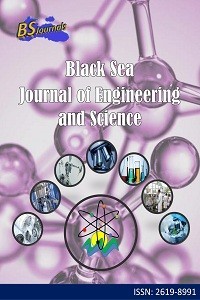Çok Noktalı Derin Çekme Prosesinde Farklı Pim Radyuslarının Etkisinin İncelenmesi
Çok noktalı şekillendirme, Derin çekme, Çok noktalı derin çekme, Pim çapı, AISI Al 3003
Investigation of the Effect of Different Pin Radius in the Multi-Point Deep Drawing Process
___
- Beglarzadeh B, Davoodi B. 2016. Numerical simulation and experimental examination of forming defects in multi-point deep drawing process. Mechanics, 22(3):182-189.
- Borchers F, Clausen B, Ehle L.C, Eich M, Epp J, Frerichs F, Hettig M, Klink A, Kohls E, Lu Y, Meyer H, Rommes B, Schneider S, Strunk R, Zielinski T. 2021. The influence of former process steps on changes in hardness, lattice and micro structure of AISI 4140 due to manufacturing processes. Metals, 11(7): 1102.
- Cai ZY, Li MZ. 2005. Finite element simulation of multi-point sheet forming process based on implicit scheme. J. Mater. Process. Technol, 161(3):449–455.
- Engin K.E, Eyercioglu O. 2017. The effect of the thickness-to-die diameter ratio on the sheet metal blanking process. Stroj. Vestn. J. Mech. Eng., 63(9): 501-509.
- Li M, Liu Y, Su S, Li G. 1999. Multi-point forming: A flexible manufacturing method for a 3-d surface sheet. J. Mater. Process. Technol, 87(1-3): 277–280.
- Li MZ, Cai ZY, Sui Z, Yan Q. 2002. Multi-point forming technology for sheet metal. J. Mater. Process. Technol, 129(1-3):333–338.
- Liu C, Li M, Fu W. 2008. Principles and apparatus of multi-point forming for sheet metal. Int. J. Adv. Manuf. Technol, 35: 1227–1233.
- Park C.S, Ku T.W, Kang B.S, Hwang S.M. 2004. Process design and blank modification in the multistage rectangular deep drawing of an extreme aspect ratio. J. Mater. Process. Technol, 153: 778-784.
- Qian ZR, Li MZ, Tan FX. 2007. The analyse on the process of multi-point forming for dish head. J. Mater. Process. Technol, 187:471–475.
- Tandoğan M, Eyercioğlu Ö, Dülger M. 2020. Principles and finite element simulation of multi-point forming technology for sheet metal. TIJMET, 3(2): 120-130.
- Tandogan M, Eyercioglu O, Engin KE. 2023. Experimental and numerical investigation on effects of pin diameter on multi-point forming. Processes, 11(2):387.
- Yaşar M, Korkmaz Z, Gavas M. 2007. Forming sheet metals by means of multi-point deep drawing method. Mater. Des. 28(10): 2647-2653.
- Zareh-Desari B, Davoodi B, Vedaei-Sabegh A. 2017. Investigation of deep drawing concept of multi-point forming process in terms of prevalent defects. Int. J. Mater. Form., 10: 193-203.
- Zhu L, Liang Q, Yu TX, Yuan P, Hu Y. 2019. Experimental and theoretical study of constant curvature multi-square punch forming process of strips under follower load. Int. J. Mech. Sci., 156: 462-473.
- Yayın Aralığı: 6
- Başlangıç: 2018
- Yayıncı: Uğur ŞEN
Comparing of CFD Contours Using Image Analysing Method: A Study on Velocity Distributions
A New Soft Set Operation: Complementary Soft Binary Piecewise Intersection (∩) Operation
Aslıhan SEZGİN, Fitnat Nur AYBEK, Akın Osman ATAGÜN
Biodiversity of Actinobacteria Isolated from Marmara and Avşa Islands in Türkiye
Ahmet Rıdvan TOPKARA, Kamil IŞIK
Chromosome Banding Properties of Neogobius fluviatilis (Pallas, 1814) (Perciformes, Gobiidae)
Sevgi ÜNAL KARAKUŞ, Muradiye KARASU AYATA, Muhammet GAFFAROĞLU
Farklı Özellikleri ve Özel Yönleri ile Bir Bitki Hormonları Grubu: Strigolaktonlar
Özge DURMAZ, Alper DURMAZ, Erdi Can AYTAR, Yasemin ÖZDENER KÖMPE
Opti-Waffle: A Technological Furniture Design and Manufacturing Model
Estimation of Air Light With Deep Learning for a Near Real-Time Image Dehazing System
Corn Disease Detection Using Transfer Learning
Determination of HMF Value and Diastase Activities in Strained Honeys Sold in Markets
